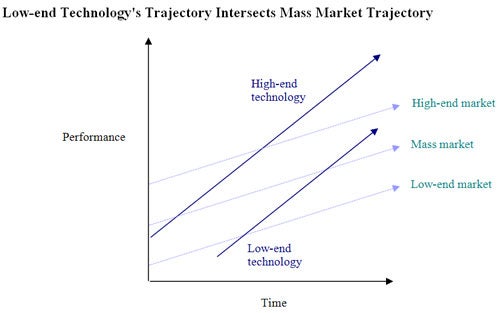Microsoft Facing a Serious "Segment Zero" Threat
Amazon grabbed headlines, entering the computing business with a bang in a head to head attack on Apple’s iPad with its new cost-effective tablet that marries the Kindle with Google’s Android software. A high-stakes race for dominance over the next generation of computing is well underway. But where is Microsoft, once the market leader, in the race to the top? Microsoft’s dominance in computer operating systems is now under greater threat than it ever has been. In fact, Microsoft isn’t even in the front pack.
When IBM signed an agreement to have Microsoft write an operating system for its new personal computer in 1980, it set into motion an enormously powerful (and profitable, at least for Microsoft) set of events: every IBM PC and IBM clone was subsequently sold with Microsoft’s MS DOS, which meant that every software application developed for those PCs would need to be designed to be compatible with MS DOS (and later, Microsoft Windows, which incorporated a graphical user interface). The cycle of network externalities that ensued has now become the familiar lore of business schools: as the availability of complementary goods for the Microsoft platform increased, more people were attracted to the Microsoft platform, and the more people adopted the Microsoft platform, the more developers wanted to make complementary goods for that platform. It is a self-reinforcing cycle that can create a nearly insurmountable advantage for a company that gets an early lead in either its installed base, or the availability of complements. There were other self-reinforcing effects as well – as people accumulated experience with Windows, they became increasingly reliant on their familiarity with the interface, making it much tougher to consider adopting a new operating system. This learning effect should not be underestimated – it is, after all, the reason nearly all of us use the QWERTY keyboard layout, despite the fact that the QWERTY keyboard was designed to slow typing down to avoid jams on a mechanical typewriter. Computers obviated the jamming problem and consequently other keyboard layouts were proposed that made more efficient use of keystrokes. These alternatives, however, were unable to gain traction. Most people are creatures of habit, and have little tolerance for the costs of learning an activity in which they believe themselves to already be proficient. Not surprisingly then, competing operating systems struggled to attract share from the Windows platform. Though Unix, Geoworks, NeXTSTEP, Linux, and the Mac OS all had interesting advantages, Microsoft’s share of the personal computer operating system market held stable at roughly 85% throughout most of the three decades since signing with IBM.
Microsoft was subsequently able to leverage its dominance with Windows into major market share in many other software markets (e.g., word processing, spreadsheet programs, presentation programs, browsers and more) and gained enormous influence over most aspects of the computer software and hardware industries. It was both revered and feared. It was, for many years, difficult to imagine how another company would ever break the network externality cycle that entrenched Microsoft’s operating system as the dominant design.
Perhaps, however, Andy Grove should have anticipated Microsoft’s unseating. As Andy Grove noted in 1998, in many industries -- including microprocessors, software, motorcycles, and electric vehicles – technologies improve faster than customer demands of those technologies increase. Firms often add features, speed, power, etc. to products faster than customers’ capacity to absorb them. Though customers may expect to have better performing products over time, their ability to fully utilize such performance improvements is slowed by the need to learn how to use new features and adapt their work and lifestyles. This means that over time, technologies initially targeting the mass market may end up delivering features the mass market does not value, and technologies that had initially only served only the very low end of the market (what Grove calls “Segment zero”) become good enough for the mass market (see the figure below). When this happens, the firms offering the formerly dominant technology may suddenly find they are losing the bulk of their sales revenue to industry contenders that do not look so low end anymore.
So where is the “segment zero” that could threaten Microsoft? Look in your pocket. Collectively, Apple’s iPhone operating system (iOS) and Google’s Android control about 60% of the market for new smartphone purchases, followed by Research in Motion’s Blackberry. Estimates put the share of Microsoft’s Windows Phone at 11%. The iOS and Android interfaces offer a double whammy of beautiful aesthetics and remarkable ease of use. The interface is so intuitive, in fact, that my four-year old son not only figured out how to find and play Angry Birds on his own, but also managed to change my phone’s wallpaper, and call his grandmother. The applications business model used for the phones is also extremely attractive to both developers and customers, and has already resulted in enormous libraries of applications that range from ridiculous to indispensible.
From a traditional economics perspective, the phone operating system market should not be that attractive to Microsoft – people do not spend as much on the applications, and the carriers have too much bargaining power, among other reasons. However, consider what happens when a smartphone operating system becomes a tablet operating system, and a tablet becomes a fully-functional computer. Suddenly, all of that mindshare that Apple and Google have achieved in smartphone operating systems becomes mindshare in personal computer operating systems. Despite years of masterminding the computing industry, Microsoft’s dominant position could evaporate before most people even realize it is under attack. We shouldn’t count Microsoft out yet because it has an impressive arsenal of capital, talent, and relationships in its armory, but it is now fighting this battle from a disadvantaged position.
